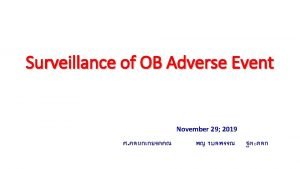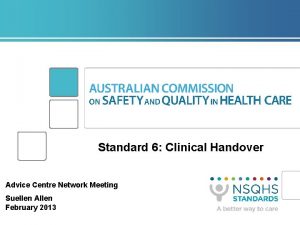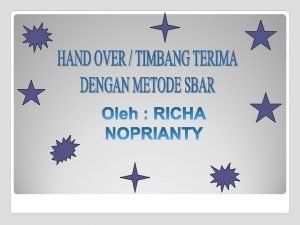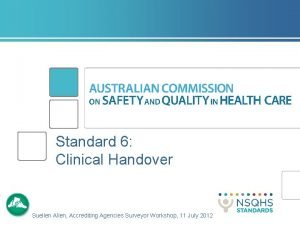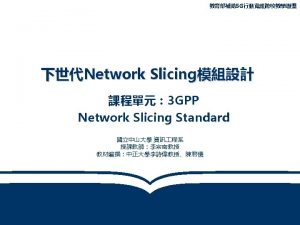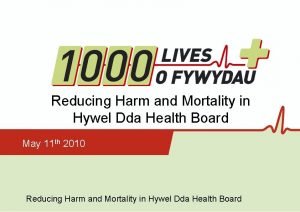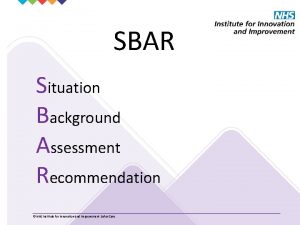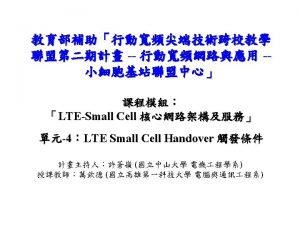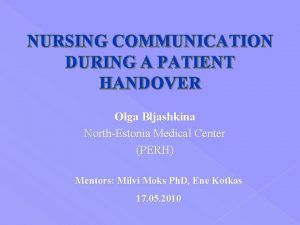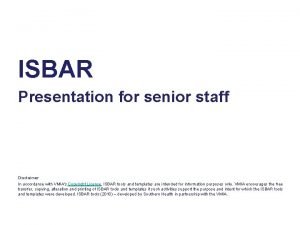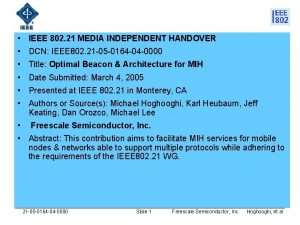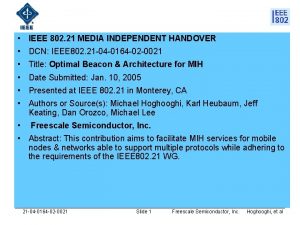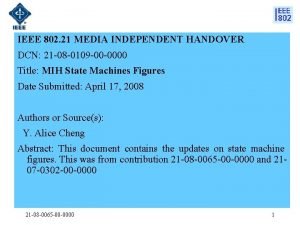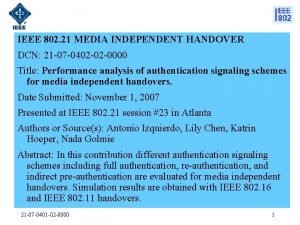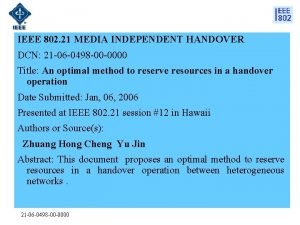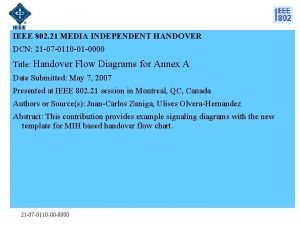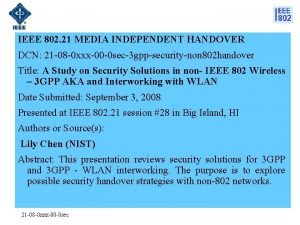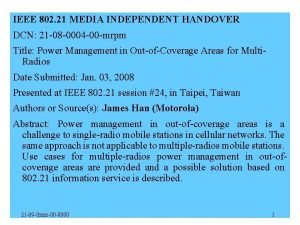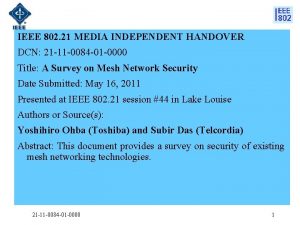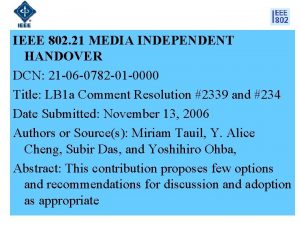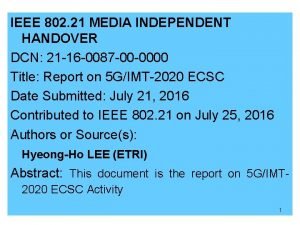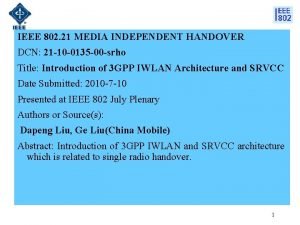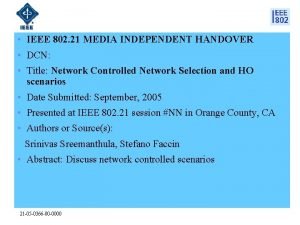IEEE 802 21 MEDIA INDEPENDENT HANDOVER DCN 21


















![A System Architecture [802. 11+802. 21] Co re Ac )] E I P( Q A System Architecture [802. 11+802. 21] Co re Ac )] E I P( Q](https://slidetodoc.com/presentation_image_h/195888f07ba4f9f972a36e9f27093de4/image-19.jpg)


- Slides: 21

IEEE 802. 21 MEDIA INDEPENDENT HANDOVER DCN: 21 -12 -0005 -00 -0000 Title: A System Architecture of Network Discovery and Selection using 802. 11 and 802. 21 features Date Submitted: January 16, 2012 Presented at IEEE 802. 11 WNG session in Jacksonville Authors or Source(s): Peretz Feder, Ajay Rajkumar and Dan Gal(ALU), Anthony Chan (Huawei), Antonio de la Oliva (UC 3 M), Farrokh Khatibi (QCOM), Charlie Perkins (Tellabs), Dapeng Liu (China Mobile), Christian Niephaus (Fraunhofer), Yoshihiro Ohba (Toshiba), Juan Carlos Zuniga (Inter. Digital), Junghoon Jee (ETRI), Subir Das(ACS) (Presenter) Abstract: This document highlights the features of 802. 21 and shows how it can complement 802. 11 interworking features and can provide a complete system architecture 1

IEEE 802. 21 presentation release statements This document has been prepared to assist the IEEE 802. 21 Working Group. It is offered as a basis for discussion and is not binding on the contributing individual(s) or organization(s). The material in this document is subject to change in form and content after further study. The contributor(s) reserve(s) the right to add, amend or withdraw material contained herein. The contributor grants a free, irrevocable license to the IEEE to incorporate material contained in this contribution, and any modifications thereof, in the creation of an IEEE Standards publication; to copyright in the IEEE’s name any IEEE Standards publication even though it may include portions of this contribution; and at the IEEE’s sole discretion to permit others to reproduce in whole or in part the resulting IEEE Standards publication. The contributor also acknowledges and accepts that this contribution may be made public by IEEE 802. 21. The contributor is familiar with IEEE patent policy, as stated in Section 6 of the IEEE-SA Standards Board bylaws <http: //standards. ieee. org/guides/bylaws/sect 6 -7. html#6> and in Understanding Patent Issues During IEEE Standards Development http: //standards. ieee. org/board/pat/faq. pdf> 2

Outline • Overview of IEEE 802. 21 • Relationship with IEEE 802. 11 Internetworking features (e. g. , 802. 11 u) • A complete system architectural view • Conclusion 3

IEEE 802. 21 Overview

Handovers: Who makes the Decision ? Measurements Triggers IEEE 802. 21 Measurements, Triggers, Neighbor Information Mobile Device (User) Neighbor Maps Service Information Network (Operators) IEEE 802. 21 enables Co-operative Handover Decision Making 5

IEEE 802. 21. Overview Ø IEEE 802. 21 is a published standard Ø The purpose is to improve the user experience of mobile device by facilitating handover between heterogeneous access networks Ø Media Independent Handover Function (MIHF) Ø 802. 21 provides mechanisms for network detection and selection, minimizing connectivity interruption while changing access link, and with an efficient battery usage Ø Defined Services: Events, Commands, and Information Ø The 802. 21 layer belongs to the control plane Ø Provides both L 2 and L 3 transports 6

IEEE 802. 21 Services(Logical Diagram) • MIES: Media Independent Event Service • MICS: Media Independent Command MIIS: Media Independent Information Service • From Link layers to Upper layers Service • From MIH users to Lower layers Acquire network information • Subscription mechanism • Local or remote Information can be accessed from any technology • L 2/L 3 communication • Its reception candynamic generateinformation an event Network selection • Advisory nature, • Examples: Link Commit, Candidate_Query neighbor maps, coverage etc. • Examples: Up, Link Down, Link zones, Parameters change 7

Media Independent Information Service MIH Information Server Network Map WLAN • List of Available Networks WWAN - e. g. , 802. 11/16, GSM, UMTS, LTE WMAN • Link Layer Information - Neighbor Maps • Higher Layer Services - Vo. IP, Emergency (E 911), VPN…. Network Type SSID/ Cell ID BSSID Operator Security Channel Qo. S Higher layer Service Data Rate GSM/HSPA 13989 N/A Oper-1 UMTS/AKA 1900 N/A E 911 9. 6 Kbps LTE 12345 N/A Oper-2 UMTS/AKA 700 N/A E 911 40 Mbps 802. 11 Enterprise 00: … Oper-3 802. 11 i 6 N/A VPN 54 Mbps 802. 16 e 3456 N/A Oper-4 PKM 11 Yes Vo. IP 40 Mbps 8

MIH Information Service Call Flow STA /UE MIH Information Server IS Server Discovery Information Service message Request (MIH_GET_REQUEST) Information Service message Response (MIH_GET_RESPONSE) 9

IEEE 802. 11 u Overview

IEEE 802. 11 u: Interworking With External Networks • IEEE 802. 11 -2011 (Includes 802. 11 u Standard) • Features : • • aiding network discovery and selection by providing information to the STA/UE about the networks prior to association enabling information transfer from external networks to STA enabling emergency services interfacing Subscription Service Provider Networks (SSPN) to 802. 11 Networks that support Interworking with External Networks • Network Discovery and Selection allows for an architecture where external information server query is included 11

802. 11 u Interworking Functions • Network discovery and selection • Discovery of suitable networks through the advertisement of parameters via management frames, for example: • access network type, roaming consortium, PLMN list • Selection of a suitable IEEE 802. 11 infrastructure using various services (e. g. , Access Network Query Protocol (ANQP)) in the BSS • Selection of an SSPN or external network with its corresponding IEEE 802. 11 infrastructure • Emergency services • Emergency Call and Network Alert support at the link level • Qo. S Map distribution • SSPN interface - service between the AP and the SSPN (Home Subscription Service Provider) 12

GAS/ANQP call Flow STA AP Provisioned Home Realm; FQDN Configured SSID Scan Request Scan Response Build the scan list; Analyze SSIDs, No AP to associate Generated ANQP GAS Init Req (bundled ANQP NAI + WAN…) GAS Init Resp (Comeback Delay=1000 TU …) ANQP Request ANQP Response Information repository GAS Comeback Req GAS Comeback Resp Defrag ANQP; Consolidate all inputs from all networks Analyze ANQP; Discover & select network Out of Scope of 802. 11 (but relevant for Wi-Fi certification process for example) Association Req 13

MIH Capability Discovery • 802. 11 u supports MIH Function through GAS (Generic Advertisement Service) • Generic Advertisement Service (GAS) provides a L 2 access to an information server (e. g. an IEEE 802. 21 IS) • While selecting Wi-Fi networks, 3 G/4 G connected device may prefer L 3 connectivity instead • 802. 11 u supports MIH query to an external source through higher layer transport • The 802. 21 IS could be accessed over L 3 after ‘Association’ has been achieved 14

IEEE 802. 21 Complements 802. 11 u from a System Perspective

802. 21 Information Service Features • 802. 21 Network Discovery and Selection function provides Information Service which is a MIH Information Server in the architecture • MIH protocol supports both L 2 and L 3 transports • • Ethertype is defined (IEEE Registry) UDP/TCP transport and ports are assigned by IANA (RFC 5677) • Similar to ANQP, MIH protocol defines a container to carry other messages • Information Service defines a number of Information Elements • Vendor specific namespace is defined • Provide both TLV and XML/RDF encodings • The multiple available IEs should not be a deterrent but viewed as an opportunity to use as/if desired 16

802. 21 Information Service Features Contd. . • MIH Server requires registration by the client to provide the service • MIH security is defined in IEEE 802. 21 a • Specification is in Rev. Com’s March agenda • Discovery of MIH Server is defined in IETF • DHCP Option (RFC 5678) • DNS Option (RFC 5679) 17

Similarities between 802. 21 IS and 802. 11 u Attribute MIH 802. 11 u Inter-access (WLAN, 3 G/4 G) Yes 802. 11 focused AP Dependency Yes UE Dependency Yes (Connection Mgr or client) Yes (Connection Mgr) AP Upgrade SW upgrade Software upgrade UE Upgrade Software Upgrade Access selection based on Operator Policy (access Yes. WAN elements can be loaded through MIH exchange Yes. WAN elements can be loaded through ANQP inquiry Per APN Decision granularity No No Standardization IEEE-802. 21 -2009 IEEE 802. 11 -2011 characteristics, application requirements, subscriber profile, charging info. , etc. )
![A System Architecture 802 11802 21 Co re Ac E I P Q A System Architecture [802. 11+802. 21] Co re Ac )] E I P( Q](https://slidetodoc.com/presentation_image_h/195888f07ba4f9f972a36e9f27093de4/image-19.jpg)
A System Architecture [802. 11+802. 21] Co re Ac )] E I P( Q e N [A pons IH s M Re e s on p s re P NQ A / S GA ce s s n etw o t r ues q e P r Q N /A S GA k n etw MIH Information Server )] E I P( Q N t [ A ues IH Req M or k Network Map List of Available Networks 802. 11 Server assisted Network Discovery 802. 21 Standard 802. 11 Standard 19

GAS/ANQP with MIH call Flow STA AP Provisioned Home Realm; FQDN MIH Information Server Configured SSID Scan Request Scan Response Build the scan list; Analyze SSIDs, No AP to associate Generated ANQP GAS Init Req (bundled ANQP NAI + WAN…) GAS Init Resp (Comeback Delay=1000 TU …) MIH [ANQP (IE) Request MIH[ANQP(IE)] Response GAS Comeback Req GAS Comeback Resp Use of 802. 21 MIH Defrag ANQP; Consolidate all inputs from all networks Analyze ANQP; Discover & select network Association Req 20

Conclusion • A system architecture comprising 802. 11 and 802. 21 is already captured in 802. 11 u and straightforward • Industry requires such a capability • This an opportunity for IEEE 802 to provide a complete system solution • Some additional work may be required and it is an opportunity to work together • • 802. 21 is discussing a work item 802. 11 ISD SG work seems to be inline with 802. 21 work item • We would like to understand address any reasoning contradicting the apparent synergy of ANQP and MIH queries to the IS 21
 Bridges from 802.x to 802.y
Bridges from 802.x to 802.y Bridges from 802.x to 802.y
Bridges from 802.x to 802.y Ieee 802
Ieee 802 Arquitetura ieee 802
Arquitetura ieee 802 El 802
El 802 Ieee 802 standard
Ieee 802 standard Ieee 802 bluetooth
Ieee 802 bluetooth 802 ieee
802 ieee Ieee 802
Ieee 802 Ieee 802 family
Ieee 802 family Ieee 802 3 compliance
Ieee 802 3 compliance Isbar communication tool
Isbar communication tool Sbar handover
Sbar handover Standard 6 clinical handover
Standard 6 clinical handover Sbar adalah
Sbar adalah Clinical handover standard 6
Clinical handover standard 6 Network slicing handover
Network slicing handover Sbar handover
Sbar handover Situation background assessment recommendation template
Situation background assessment recommendation template Mobility mode
Mobility mode Sbar handover
Sbar handover Isbar handover
Isbar handover











